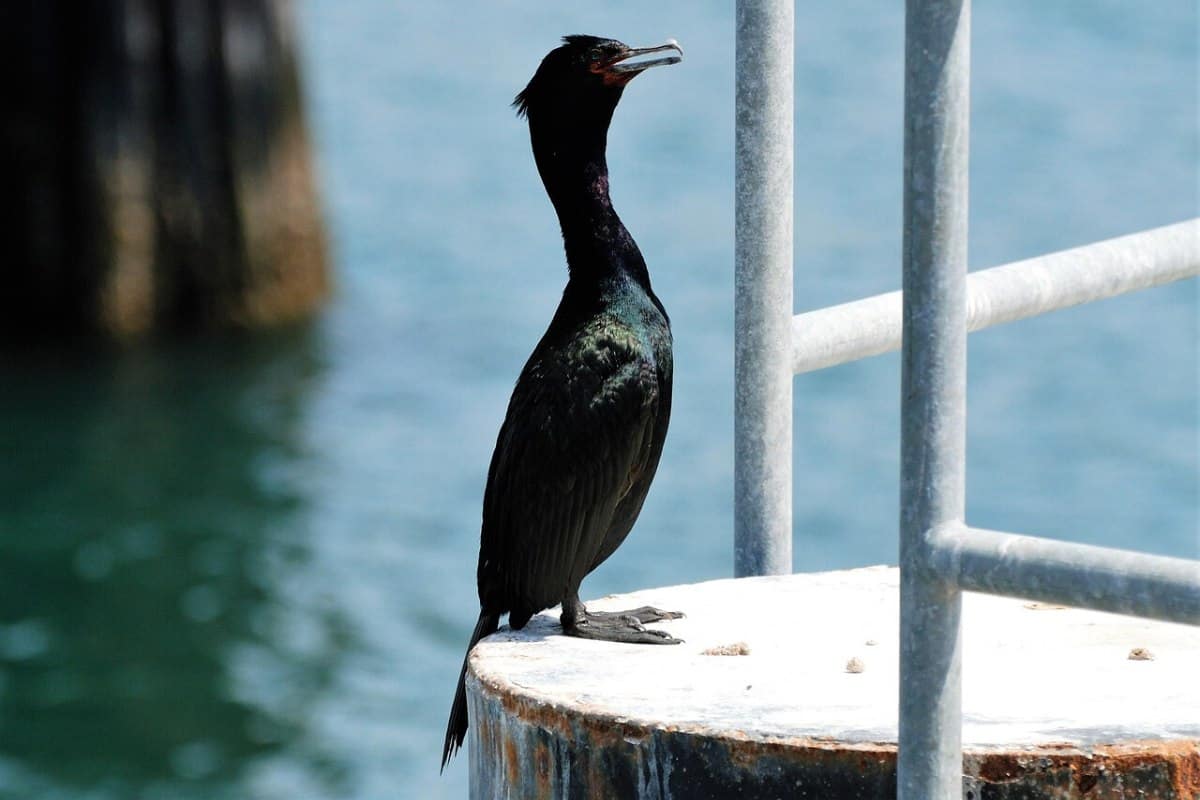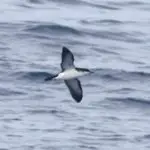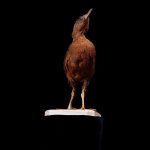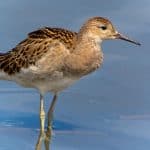Common Name: Pelagic Cormorant
Scientific Name: (Urile pelagicus)| Size | Diet | Range in Hawaii | Status in Hawaii |
|---|---|---|---|
| 22 in. - 24 in. | fish, amphibians, and crustaceans | Northwestern Hawaiian Islands | Least Concern |
The Pelagic Cormorant, also known as Urile pelagicus, is a seabird species that is native to the North Pacific Ocean. While the species is not native to Hawaii, it has been known to make occasional appearances on the islands as a non-breeding visitor and vagrant. With its distinctive appearance and unique behavior, the Pelagic Cormorant is a fascinating bird species that has captured the attention of birdwatchers and avian enthusiasts around the world.
In this article, we will explore the world of the Pelagic Cormorant, its unique characteristics, and its occasional presence in Hawaii.
Pelagic Cormorant
Appearance

The Pelagic Cormorant is a captivating seabird with a distinct and striking appearance. With its glossy black plumage, this cormorant exudes elegance as it glides gracefully above the ocean waves. It has a slender body and a long, slender neck that gives it a regal posture.
During the non-breeding season, these cormorants are black overall. But during the breeding season they develop a greenish-purple metallic sheen over their black feathers and a white patch on their flanks.
On average, the Pelagic Cormorant measures around 22 to 24 inches (55 to 61 centimeters) in length, making it a medium-sized cormorant species.
Diet
The Pelagic Cormorant is a skilled and opportunistic hunter, making its living as a master fisherman in the vast oceanic waters. The cormorant’s diet primarily consists of small fish, such as herring, anchovies, and rockfish, which it catches with remarkable precision. Fish are caught by swimming, and they can stay underwater for over 2 minutes while chasing their prey. Large webbed feet help to propel and steer them underwater.
Nesting
These seabirds are known for their unique choice of nesting sites, preferring to build their homes on rocky coastal cliffs and steep ledges, away from the prying eyes of potential predators. The cormorants demonstrate exceptional agility as they navigate the rugged terrain, carefully selecting crevices and fissures in the cliffs to create their nests. Using seaweed, grass, and other available materials, they construct compact and well-crafted nests that provide a safe haven for their eggs and chicks.
During the breeding season, these coastal cliffs transform into bustling colonies, adorned with the glossy black plumage of the adult cormorants. Both male and female birds play an active role in incubating the eggs and tending to the chicks, showcasing a strong sense of partnership and dedication to their offspring. As the young cormorants grow, they eagerly await their turn to fledge and explore the open sea.
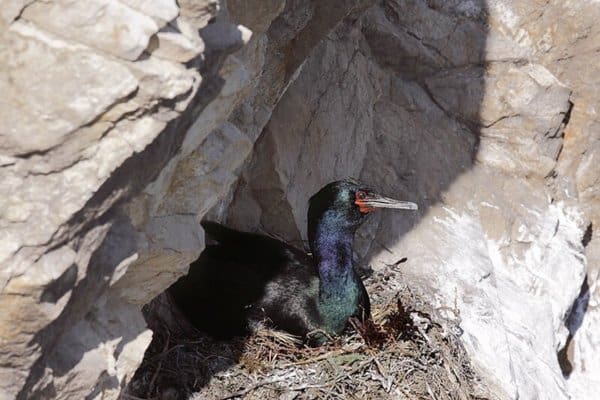
Behavior
With its sleek and streamlined body, the cormorant can dive to considerable depths, remaining submerged for impressive durations before resurfacing. After a successful dive, it perches on rocky outcrops to spread its wings and dry its feathers, as its plumage lacks waterproofing oils that many other waterbirds possess.
During the breeding season, the cliffs come alive with the social interactions of the Pelagic Cormorant colonies. Males engage in striking displays, showing off their glossy black plumage and white thigh patches to attract potential mates. Both parents actively participate in incubating the eggs and caring for the chicks, fostering a strong sense of familial responsibility.
The Pelagic Cormorant’s coastal cliff nests, perched precariously above crashing waves, demonstrate their remarkable ability to adapt to challenging environments. This behavior showcases the cormorants’ resilience and resourcefulness as they carve out their place in the rugged coastal landscape.
Habitat
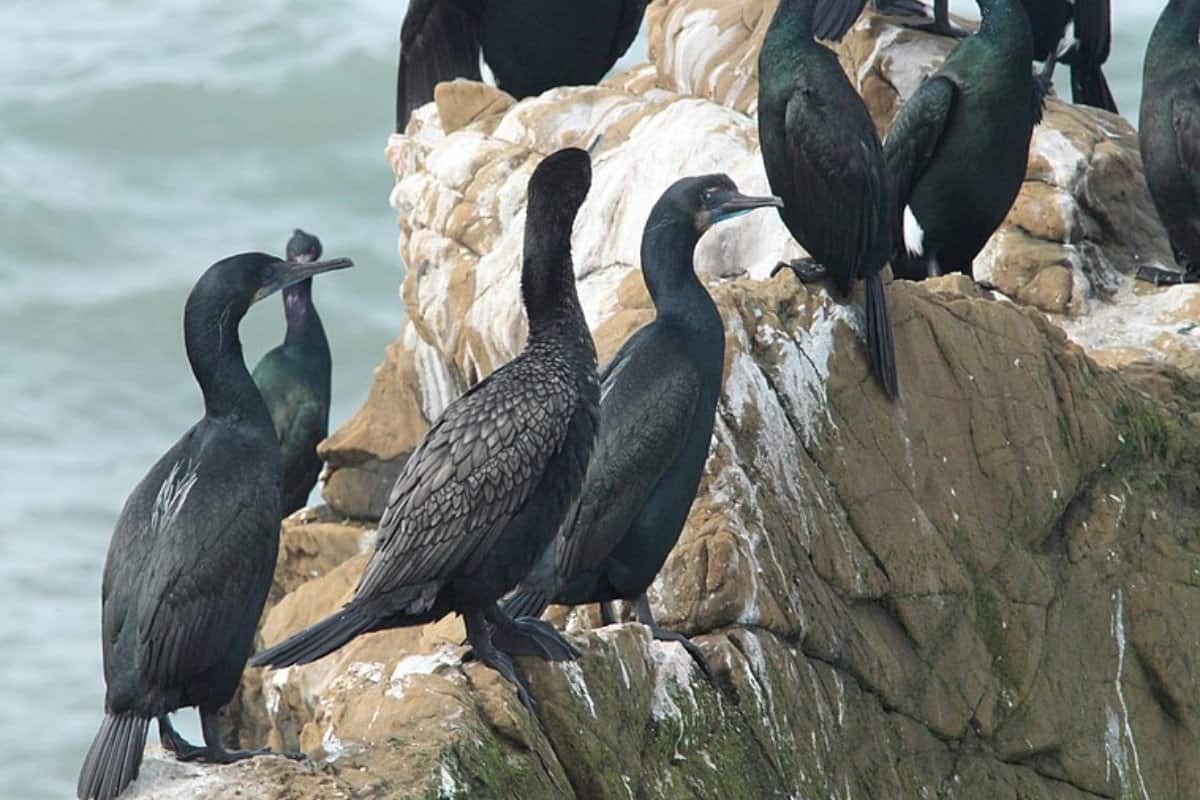
The Pelagic Cormorant inhabits rugged coastal cliffs of the Pacific Ocean. These skilled seabirds nest on steep, rocky ledges, displaying remarkable agility. Their habitat provides safety, abundant food, and a dynamic environment where they thrive as expert underwater hunters. Because they rely on the ocean for food and rocky cliffs for roosting, they are rarely found inland.
Range
Their typical range includes most of the western coast of North America from Alaska to Mexico. They are also found on islands of the Bering Strait and along northeastern Russia. The Pelagic Cormorant is a non-breeding visitor and vagrant in Hawaii, occasionally recorded in the Northwestern Hawaiian Islands. Occasional and accidental occurrences of this species have been also been recorded on Laysan and Midway islands.
Conservation Status
The Pelagic Cormorant (Urile pelagicus) is listed as a species of Least Concern by the International Union for Conservation of Nature (IUCN). This designation indicates that the overall population of the species is stable and not currently facing significant threats that would warrant a higher conservation status.
Interesting Facts
1. Saltwater resilience
Unlike most waterbirds, the Pelagic Cormorant’s plumage lacks waterproofing oils, making it less buoyant in water and helping them to dive deeper while swimming after fish. After fishing dives, they can be seen perched with wings spread open, drying their feathers to restore buoyancy.
2. Seasonal nesting
Breeding activities typically occur between March and July, varying slightly across their range.
3. Interspecies competition
While nesting, Pelagic Cormorants often compete with other seabird species, such as gulls and puffins, for limited nesting space on the coastal cliffs.
4. Feeding frenzies
When a group of Pelagic Cormorants spot a school of fish, they may engage in “feeding frenzies,” diving en masse to exploit the abundant prey.
5. Precocial chicks
Pelagic Cormorant chicks are born with open eyes, covered in down feathers, and capable of walking shortly after hatching. This precocial development enables them to quickly explore their rocky nesting sites.
Frequently Asked Questions
1. Are Pelagic Cormorants solitary birds when not breeding?
Outside the breeding season, Pelagic Cormorants may be found in smaller groups or as solitary individuals as they disperse from their breeding colonies.
2. What role do Pelagic Cormorants play in the marine ecosystem?
Pelagic Cormorants are top predators in their coastal habitats and help regulate fish populations, contributing to the balance of the marine ecosystem.
3. How do Pelagic Cormorants interact with humans?
Pelagic Cormorants are not known to have significant direct interactions with humans. Their choice of nesting sites on remote cliffs helps minimize disturbances.
4. What are the main threats to Pelagic Cormorant populations in the future?
While they are currently listed as a species of Least Concern, potential threats to Pelagic Cormorants include habitat loss, human disturbance, and changes in food availability due to climate-related impacts on marine ecosystems.
5. What is the typical lifespan of a Pelagic Cormorant?
Pelagic Cormorants generally have a lifespan of about 10 to 20 years in the wild. However, some individuals may live longer under favorable conditions with access to ample food and suitable nesting habitats.
